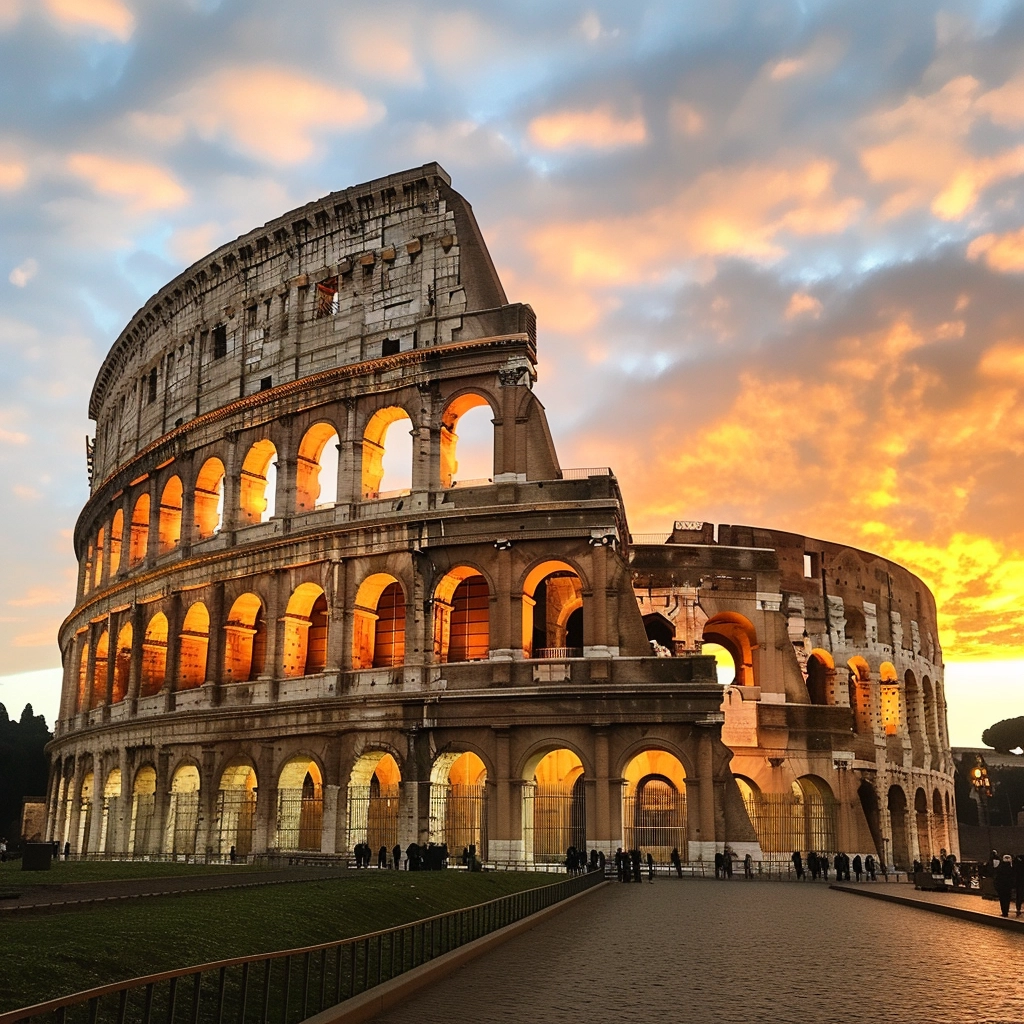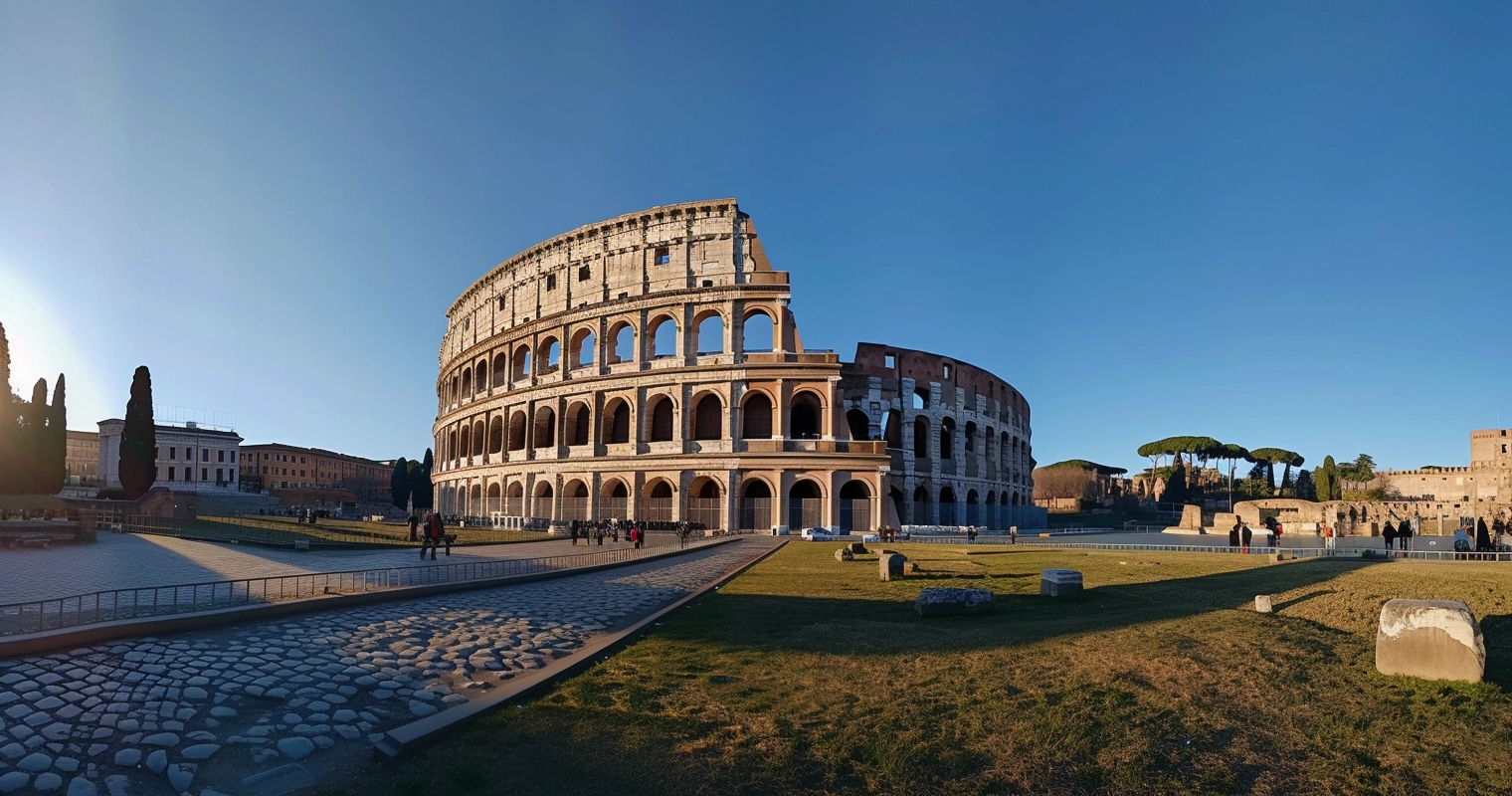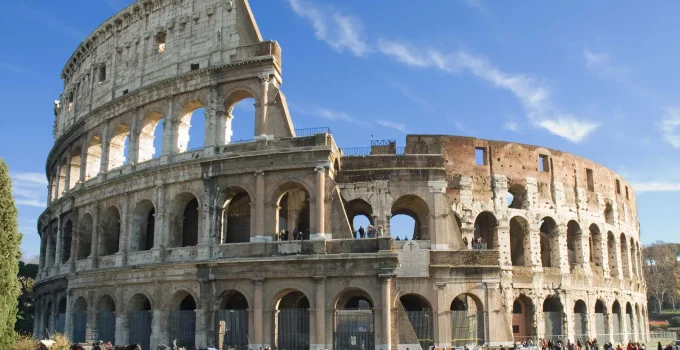Welcome to the grand and iconic world of The Colosseum, where legends were made and history was carved into stone. Standing tall and majestic in the heart of Rome, this ancient amphitheater holds within its walls the tales of gladiators, emperors, and ancient spectacles that continue to captivate the imagination.
As you step into this architectural masterpiece, you’ll be transported back in time to the days of the Roman Empire. Feel the energy that once filled these walls as you explore the labyrinthine corridors, awe-inspiring chambers, and the legendary arena itself. Colosseum’s remarkable design and ingenious engineering have withstood the test of time, serving as a testament to the ingenuity and mastery of ancient Roman architecture.
Immerse yourself in the rich history and cultural significance of this awe-inspiring landmark. Discover the secrets and stories buried within its ancient stones. Learn about the gladiatorial battles that took place, the grand spectacles that unfolded, and the sheer magnitude of the events that once crowded this mesmerizing arena.
Join us as we unravel the captivating history of Colosseum, from its grand wd bos construction to its enduring legacy as a symbol of ancient Rome’s glory. Are you ready to embark on an unforgettable journey through time? Let us be your guide as we delve into the captivating tale of Colosseum.

Contents
- 1 Historical Significance of The Colosseum
- 2 Architecture and Design of The Colosseum
- 3 Events and Entertainment at The Colosseum
- 4 Restoration and Preservation Efforts of The Colosseum
- 5 Interesting Facts about The Colosseum
- 6 Visiting The Colosseum: Tips and Guidelines
- 7 Nearby Attractions and Landmarks
- 8 The Impact of The Colosseum on Modern Society
- 9 The Enduring Legacy of The Colosseum
- 10 Author
Historical Significance of The Colosseum
The Colosseum, also known as the Flavian Amphitheatre, holds immense historical significance. Built during the reign of the Flavian dynasty in the 1st century AD, it stands as an enduring symbol of the power and grandeur of ancient Rome. The construction of this monumental amphitheater was commissioned by Emperor Vespasian in 70 AD and was completed by his son, Titus, in 80 AD.
During its heyday, The Colosseum hosted a wide range of events, including gladiatorial contests, mock sea battles, animal hunts, and theatrical performances. These spectacles served as a means to entertain the masses and maintain the favor of the people. The Colosseum became a platform for showcasing the might and authority of the Roman Empire, leaving a lasting impression on the collective memory of civilization.
The amphitheater could accommodate over 50,000 spectators, making it one of the largest structures of its kind in the ancient world. Its elliptical shape, towering height, and ingenious design allowed for efficient crowd control and optimal viewing angles, ensuring that every spectator had a clear view of the action unfolding in the arena.
The Colosseum’s historical significance extends beyond its architectural marvel. It witnessed countless gladiatorial battles, where trained fighters, often slaves or prisoners, fought for their lives. The bloodshed and bravery displayed within its walls have become the stuff of legends, immortalizing the gladiators who risked everything for the amusement of the crowd.
Architecture and Design of The Colosseum
The Colosseum’s architectural brilliance is a testament to the ingenuity and engineering prowess of the ancient Romans. Its design showcases the meticulous attention to detail and the ambition to create something truly extraordinary.
The amphitheater was built using concrete and stone, with travertine limestone as the primary material. The exterior facade featured three levels of arches, each adorned with decorative elements such as statues and reliefs. The lower level consisted of Doric columns, the middle level featured Ionic columns, and the upper level showcased Corinthian columns, representing the three classical orders of ancient Greek architecture.
The elliptical shape of The Colosseum allowed for optimal crowd management and ensured that every spectator had an unobstructed view of the events taking place in the arena. The seating arrangement was divided into different sections, reflecting the hierarchical structure of Roman society. The closer one was to the arena, the higher their social status.
Underneath the arena lay a complex network of tunnels and chambers known as the hypogeum. This underground system served as a backstage area for performers and gladiators and housed the mechanisms that facilitated the grand spectacles. Elevators, trapdoors, and pulleys were used to transport animals, combatants, and props into the arena, adding an element of surprise and drama to the events.
The Colosseum’s architectural design not only catered to the practical needs of hosting large-scale events but also showcased the mastery of Roman engineering. Its innovative use of materials, sophisticated crowd control mechanisms, and visually striking aesthetics continue to inspire architects and historians to this day.
Events and Entertainment at The Colosseum
The Colosseum was synonymous with grand spectacles and thrilling entertainment. It played host to a wide array of events that captivated the masses and left a lasting impact on the collective memory of ancient Rome.
One of the most infamous events held at The Colosseum was the gladiatorial contests. These battles pitted skilled fighters against each other in mortal combat, testing their strength, skill, and courage. Gladiators came from all walks of life, including slaves, prisoners of war, and even free men seeking fame and fortune. The battles were often brutal and bloody, with the crowd eagerly anticipating the outcome.
In addition to gladiatorial contests, The Colosseum also hosted mock sea battles known as naumachiae. The arena could be flooded, creating a makeshift naval battleground complete with ships and combatants. These spectacles were meant to mimic real naval battles and provided the audience with a thrilling and immersive experience.
Animal hunts, known as venationes, were another popular form of entertainment at The Colosseum. These events involved exotic animals, such as lions, tigers, and elephants, being pitted against each other or against armed hunters. The hunts were a display of the Roman Empire’s wealth, power, and dominance over the natural world.
The Colosseum also served as a venue for theatrical performances, including plays, pantomimes, and reenactments of famous battles. These performances showcased the artistic talents of actors, dancers, and musicians, further enhancing the cultural significance of the amphitheater.
The events held at The Colosseum were not only meant for entertainment but also served political and social purposes. They were a way for emperors to gain favor with the people, solidify their power, and maintain social order. The grandeur and scale of these spectacles were a testament to the might and authority of the Roman Empire.

Restoration and Preservation Efforts of The Colosseum
Over the centuries, The Colosseum has weathered the ravages of time, earthquakes, and human intervention. Despite its enduring strength, the amphitheater has required extensive restoration and preservation efforts to ensure its longevity and accessibility to future generations.
The first significant restoration of The Colosseum took place under the rule of Emperor Domitian in the late 1st century AD. He initiated the construction of the hypogeum, transforming the underground area into a complex network of chambers and tunnels.
In the following centuries, The Colosseum fell into disrepair as it was no longer used for its original purpose. The once grand amphitheater became a quarry for building materials, resulting in significant damage to its structure. Additionally, earthquakes and natural disasters further weakened the already deteriorating monument.
In the 18th and 19th centuries, various restoration efforts were undertaken to preserve The Colosseum. Pope Benedict XIV commissioned the first major restoration in 1749, with subsequent interventions carried out by later popes and the Italian government. These restoration projects aimed to stabilize the structure, reinforce the arches, and protect the amphitheater from further decay.
Today, The Colosseum stands as a testament to the perseverance and dedication of those who have worked tirelessly to restore and preserve this iconic landmark. Ongoing efforts continue to ensure that future generations can marvel at its architectural splendor and immerse themselves in its rich history.
Interesting Facts about The Colosseum
The Colosseum is a treasure trove of intriguing facts and lesser-known details that add to its mystique and allure. Here are a few fascinating tidbits about this ancient wonder:
- The Colosseum could be flooded for naval battles, thanks to its intricate system of aqueducts and drains.
- The amphitheater had a retractable awning known as the velarium, which provided shade for the spectators.
- It is estimated that over 500,000 people and over a million wild animals lost their lives in the events held at The Colosseum.
- The Colosseum was not only a venue for bloodshed but also hosted public executions and religious ceremonies.
- The amphitheater’s original name, the Flavian Amphitheatre, was derived from the Flavian dynasty under which it was built.
- The Colosseum’s exterior facade was once adorned with statues, some of which have been lost to time.
- Contrary to popular belief, the thumbs-up gesture did not signify mercy but rather a request for the losing gladiator to be put to death.
These intriguing facts offer a glimpse into the fascinating world of The Colosseum, shedding light on its multifaceted history and cultural significance.
Visiting The Colosseum: Tips and Guidelines
If you’re planning a visit to The Colosseum, here are some tips and guidelines to ensure a memorable and enriching experience:
- Purchase tickets in advance: The Colosseum attracts a large number of visitors, so it’s advisable to book your tickets online to avoid long queues.
- Guided tours: Consider joining a guided tour to gain deeper insights into the history and significance of The Colosseum. Knowledgeable guides can provide valuable context and answer any questions you may have.
- Timing: Visit early in the morning or late in the afternoon to avoid crowds and enjoy a more serene atmosphere.
- Comfortable footwear: The Colosseum is vast, and you’ll be doing a fair amount of walking, so wear comfortable footwear to ensure a pleasant experience.
- Respect the monument: The Colosseum is a UNESCO World Heritage Site and a symbol of ancient Rome’s legacy. Treat it with respect, follow the rules, and refrain from causing any damage to the structure or its surroundings.
By following these tips, you’ll be able to make the most of your visit and fully appreciate the grandeur and historical significance of The Colosseum.

Nearby Attractions and Landmarks
While The Colosseum is undoubtedly the star attraction in Rome, there are several other nearby landmarks and attractions that are worth exploring. Here are some notable sites that you can visit during your time in the Eternal City:
- Roman Forum: Located just a short walk from The Colosseum, the Roman Forum was the center of political, commercial, and social life in ancient Rome. Explore the ruins of temples, basilicas, and public spaces that were once at the heart of the Roman Empire.
- Palatine Hill: Adjacent to The Colosseum and the Roman Forum, Palatine Hill offers breathtaking views of the ancient city. It was the site of the imperial palaces and is steeped in myth and history.
- Capitoline Hill: Considered the smallest and most important of Rome’s seven hills, Capitoline Hill is home to the Capitoline Museums, which house a vast collection of art and artifacts from ancient Rome.
- Arch of Constantine: Located near The Colosseum, the Arch of Constantine is a triumphal arch that commemorates the victory of Emperor Constantine I. Admire the intricate reliefs and sculptures that adorn this historic monument.
- Circus Maximus: Just a short distance away from The Colosseum, Circus Maximus was the largest chariot racing stadium in ancient Rome. While the original structure is no longer standing, you can explore the grounds and imagine the excitement of the races that once took place here.
These nearby attractions offer a deeper understanding of ancient Rome’s rich history and complement the experience of visiting The Colosseum.
The Impact of The Colosseum on Modern Society
The Colosseum’s influence extends far beyond the realm of ancient history. Its enduring legacy has permeated various aspects of modern society, serving as a source of inspiration for art, literature, and popular culture.
The iconic image of The Colosseum has been captured in countless paintings, photographs, and sketches. Its architectural grandeur and historical significance have made it a favorite subject for artists seeking to capture the essence of ancient Rome.
Literature also bears witness to The Colosseum’s cultural impact. Numerous novels, poems, and plays have been inspired by the amphitheater’s grandeur and the events that unfolded within its walls. From Shakespeare’s “Julius Caesar” to modern-day novels set in ancient Rome, The Colosseum continues to captivate the imaginations of writers and readers alike.
In popular culture, The Colosseum has been featured in numerous films, television shows, and video games. Its dramatic setting and association with gladiatorial battles have made it a popular backdrop for epic action sequences and historical dramas. The amphitheater’s enduring presence in popular culture serves as a testament to its universal appeal and timeless allure.
Furthermore, The Colosseum’s status as a UNESCO World Heritage Site has solidified its importance as a global cultural icon. Its inclusion on this prestigious list ensures that it will be protected and preserved for future generations to explore and appreciate.
The Enduring Legacy of The Colosseum
As we conclude our journey through the captivating history of The Colosseum, we are left in awe of its grandeur, architectural brilliance, and historical significance. This ancient amphitheater stands as a testament to the power and ingenuity of the Roman Empire, capturing the imagination of visitors from around the world.
The Colosseum’s immense cultural and historical impact continues to resonate to this day. It serves as a reminder of the achievements of ancient Rome, the grand spectacles that once unfolded within its walls, and the enduring legacy of a civilization that shaped the modern world.
If you’ve enjoyed delving into the captivating tale of The Colosseum and wish to continue your exploration of transformative historical narratives, we invite you to read our insightful article on online learning. Just as The Colosseum stands as a testament to the Roman Empire’s legacy, online learning is shaping the future of education and the way we acquire knowledge in our digital age. Join us as we explore this modern educational revolution, offering perspectives on its impact, benefits, and the endless possibilities it holds for learners worldwide.




